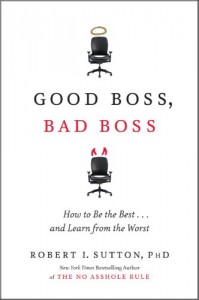Normally, I am obsessive when I write book reviews.
Reviewing other scholars’ books is a professional responsibility that I take seriously. I try to give each book a thoughtful, thorough reading, which requires several passes through the book with post-its and a pencil, and usually results in a long, dense analysis like this one.
 Which is why it is so counter-normative for me to write this particular review of Bob Sutton’s Good Boss, Bad Boss. Not the book, but the first page. (Actually, not even the first page, but the first paragraph.)
Which is why it is so counter-normative for me to write this particular review of Bob Sutton’s Good Boss, Bad Boss. Not the book, but the first page. (Actually, not even the first page, but the first paragraph.)
Yes, this is a review of the first page of Good Boss, Bad Boss.
The first page was not where I started my review of Good Boss, Bad Boss. I take a modified Adler-esque approach to book reading, with a look at the Table of Contents, a skim across the final chapter, a more-than-cursory examination of the index, and always taking note of the dedication. These are all ways to get acquainted with a book and its intentions before diving in. Since I already had acquainted myself with Good Boss, Bad Boss from these activities, I believed I knew what I was getting into.
Hah.
I only made it to the first page of the first chapter, before I had to stop reading Good Boss, Bad Boss.
Why, you ask?
- It’s not that I felt I’d already gotten all the goodies from the Table of Contents (Sutton is no Seth Godin, in that respect). I was sure that all 275 pages would be worthwhile and valuable.
- It wasn’t that I didn’t have enough time to finish Good Boss, Bad Boss. Yes, my spouse did take the review copy from my desk and read it front to back before I had the chance, but he did give it back to me.
- It’s not that I haven’t continued reading it– after several trips to and from the shore I’m nearly done.
- It wasn’t even Penelope Trunk’s predictably irreverent review of 3 business books that nudged me to try a different strategy.
No, dear reader, none of that explains why I am only offering up to you, at least today, a review of just the first page.
Here’s what explains it:
21 million
In context, that would be:
“There are at least 21 million bosses in the United States.”
 I cannot seem to get past that number, right there on the first page, because of all that this number implies about good bosses, bad bosses and why 21 million people should read this book.
I cannot seem to get past that number, right there on the first page, because of all that this number implies about good bosses, bad bosses and why 21 million people should read this book.
Quantify the possible benefits
Until I read that first paragraph from Bob, I had never before put a hard number to the potential community of folks using soft skills to guide people in organizations.
Whether you call them “bosses” or “managers”, 21 million is a lot of people. It’s slightly less than three times the size of New York City, nine times the size of Chicago, and about 150 times the number of MBA graduates this year.
For a scholar/guru like Bob who bases his recommendations on evidence and hard facts, surely there is nothing more evident than that there are a lot of managers who might become better bosses. Whatever improvements these 21,000,000 bosses might make, they will surely make a difference in the work lives of the larger number of people who work for them.
Imagine
Imagine if just one percent of these managers (21,000 people) read Good Boss, Bad Boss (past the first paragraph, of course). What if each of these 21,000 people put into practice just one of Bob’s recommendations?
What if one percent of the managers in the US decided to:
1. Adopt the right mindset
2. Take control
3. Strive to Be Wise.
4. Distinguish between Stars & Rotten Apples
5. Link Talk and Action (my personal favorite, for obvious reasons)
6. Serve as a Human Shield
7. Step up to do the Dirty Work, or
8. Squelch (their) Inner Bosshole?
It may not seem like a lot, getting one percent of a population to adopt just one behavior. But consider a stock market analogy — when a share price goes up one percent, like maybe a quarter or a half point, that small percentage shift translates into a whole lot of dollars.
A small percentage of improved managers translates into a significant absolute number of improved workplaces and work lives, not to mention work results.
 I image that Bob has high hopes for this book, not for high sales or lots of buzz, but for high impact. Surely, he expects (as well he should) that readers will follow Good Boss, Bad Boss beyond the first page, and the first chapter, to their first effort to do something better as a boss.
I image that Bob has high hopes for this book, not for high sales or lots of buzz, but for high impact. Surely, he expects (as well he should) that readers will follow Good Boss, Bad Boss beyond the first page, and the first chapter, to their first effort to do something better as a boss.
I’m really stuck on those numbers: 21 million bosses, 21 times X million employees. I think about the potential for positive change that resides in a compelling, fluid, reasonable, well-grounded, realistic book about becoming a better boss.
I just have to stop reading, and savor the possibilities.
Following The Wall Street Journal’s recommendation, I’ve been taking Good Boss, Bad Boss down the shore to enjoy. On the beach, I’ve been able to alternate between reading the book and imaging a workplace where bosses worked conscientiously to improve their management practices. I’ve been able to wonder what my own work life might have been like if I’d had more bosses willing to do the dirty work. I’ve also been able to reflect on whether, when I’ve been the boss, I did all that I could to serve as a human shield so that good people could do good work.
I don’t think that it requires a quiet beach day, or glamorous business travel, for Good Boss, Bad Boss get you thinking about how to be a better boss. Read it on the train, in the airport, or on the sly so nobody puts any pressure on you to pony up with new behaviors until you’re ready. But,
Be ready to stop, put the book down, and think about the deceptively simple advice. It can stop you in your tracks, no matter what you were expecting.
I’ve got evidence for that recommendation– look what happened for me, on the very first page.
See also:
Good Boss, Bad Boss: How To Be The Best And Learn From The Worst. My Review by Brett Simmons
Management Excellence Book Series Kicks Off Featuring Good Boss, Bad Boss, by Art Petty
Being a Good Boss is Pretty Damn Hard: Reflections on Publication Day by Bob Sutton
[Disclosure: I am not an objective reviewer of this book… I got a review copy for free, which of course obligates me to be delighted by a free book, my favorite kind of gift. And, I’ve known Bob as a colleague since I was a graduate student and he was researching organizational death. Still waiting for the book “How Asshole Managers Kill Organizations”, to complete the cycle. ]
 I am an organizational consultant, change advocate, and organizational identity/reputation scholar with a PhD in leadership & organizations. I research, write about, and consult with organizations on the relationships between organizational identity, actions, and purpose. I teach Technology Management, part-time, at Stevens Institute of Technology.
My current research focuses on how social technologies in the workplace can drive organizational change, generate meaning, and catalyze purpose. See the
I am an organizational consultant, change advocate, and organizational identity/reputation scholar with a PhD in leadership & organizations. I research, write about, and consult with organizations on the relationships between organizational identity, actions, and purpose. I teach Technology Management, part-time, at Stevens Institute of Technology.
My current research focuses on how social technologies in the workplace can drive organizational change, generate meaning, and catalyze purpose. See the 
{ 5 comments }
Now I’m intrigued… a book that stops you in your tracks before the 30th word (estimated) has to be unusual. And that’s some recommendation. Note to self – look out for it come November.
Hi Lucy-
I’m glad that the book as piqued your interest! Given your own expertise in reading between the lines of how companies present themselves, I’d love to see your take-aways from Good Boss Bad Boss.
The writing is so straightforward and the principles are so simple (when you get down to it) that it could be tempting for some readers just to speed-read through, expecting to glean insights rather than letting insights steep in. So, in this case, slower and interrupted is better. (I rarely feel that slower and interrupted reading improves my comprehension, but in this case it did.)
Good news- the book is already available on Amazon as well as in your favorite airport. cv
Reflecting on my career, certain names come quickly to mind. Having experienced both the good and the bad, I am also reminded that this study by Professor Sutton could easily apply to the world of coaching. From 5th grade baseball to college and beyond. I offer up the name of one good coach, John Wooden.
Song “Sweetest Lemonade” hear @ URL: http://www.youtube.com/watch?v=JYcHW1kuP-k A song about the bad boss, improving your position in life, and never settling
Interesting review! Yes it is mind boggling how many bosses are out there plus their effects on millions of employees. My PhD research is more about how someone can detect a bad boss -have got 4 types of bad boss worked out. The problem is that millions of people suffer bad bosses as they do not recognise them as such or are resigned to having low grade work experiences. I honestly don’t think that there are many bosses/leaders/executives/senior managers who truly want to change their life-time habits as they are blind to what they are doing and few people are strong enough to front them and tell them the truth.
Authenticity is the key, if you FEEL the boss is authentic you are probably working with a good boss.
That’s why I like your site and wish more people would read the book.
Comments on this entry are closed.
{ 1 trackback }